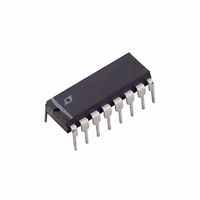LT1204CN Linear Technology, LT1204CN Datasheet - Page 10

LT1204CN
Manufacturer Part Number
LT1204CN
Description
IC VIDEO MUX CFA 75MHZ 4IN 16DIP
Manufacturer
Linear Technology
Datasheet
1.LT1204CSWPBF.pdf
(20 pages)
Specifications of LT1204CN
Applications
4:1 Multiplexer-Amplifier
Number Of Circuits
1
-3db Bandwidth
75MHz
Slew Rate
1000 V/µs
Current - Supply
19mA
Current - Output / Channel
125mA
Voltage - Supply, Single/dual (±)
10 V ~ 30 V, ±5 V ~ 15 V
Mounting Type
Through Hole
Package / Case
16-DIP (0.300", 7.62mm)
Lead Free Status / RoHS Status
Contains lead / RoHS non-compliant
Available stocks
Company
Part Number
Manufacturer
Quantity
Price
Part Number:
LT1204CN#PBF
Manufacturer:
LINEAR/凌特
Quantity:
20 000
LT1204
A
Capacitance on the Inverting Input
Current feedback amplifiers require resistive feedback
from the output to the inverting input for stable operation.
Take care to minimize the stray capacitance between the
output and the inverting input. Capacitance on the invert-
ing input to ground will cause peaking in the frequency
response and overshoot in the transient response.
Capacitive Loads
The LT1204 can drive capacitive loads directly when the
proper value of feedback resistor is used. The graph of
Maximum Capacitive Load vs Feedback Resistor should
be used to select the appropriate value. The value shown
is for 5dB peaking when driving a 1k load at a gain of 2.
This is a worst-case condition. The amplifier is more
stable at higher gains and driving heavier loads. Alterna-
tively, a small resistor (10 to 20 ) can be put in series
with the output to isolate the capacitive load from the
amplifier output. This has the advantage that the ampli-
fier bandwidth is only reduced when the capacitive load
is present. The disadvantage is that the gain is a function
of load resistance.
Slew Rate
The slew rate of the current feedback amplifier on the
LT1204 is not independent of the amplifier gain the way
slew rate is in a traditional op amp. This is because both the
input and the output stage have slew rate limitations. In
high gain settings the signal amplitude between the nega-
tive input and any driven positive input is small and the
overall slew rate is that of the output stage. For gains less
than 10, the overall slew rate is limited by the input stage.
The input slew rate of the LT1204 is approximately 135V/ s
and is set by internal currents and capacitances. The
output slew rate is set by the value of the feedback
resistors and the internal capacitances. At a gain of 10 with
a 1k feedback resistor and 15 supplies, the output slew
rate is typically 1000V/ s. Larger feedback resistors will
reduce the slew rate as will lower supply voltages, similar
to the way the bandwidth is reduced.
The graph, Maximum Undistorted Output vs Frequency,
relates the slew rate limitations to sinusoidal inputs for
various gain configurations.
10
PPLICATI
O
U
S
I FOR ATIO
U
W
U
Switching Characteristics and Pin 8
Switching between channels is a “make-before-break”
condition where both inputs are on momentarily. The
buffers isolate the inputs when the “make-before-break”
switching occurs. The input with the largest positive
voltage determines the output level. If both inputs are
equal, there is only a 40mV error at the input of the CFA
during the transition. The reference adjust (Pin 8) allows
the user to trade off positive input voltage range for
switching time. For example, on 15V supplies, setting
the voltage on Pin 8 to – 6.8V reduces the switching
transient to a 50ns duration, and reduces the positive input
range from 6V to 2.35V. The negative input range remains
unchanged at – 6V. When switching video “in picture,” this
short transient is imperceptible even on high quality
V
A
V
A
S
V
S
V
= 15V
= 2
= 15V
= 10
Large-Signal Transient Response
Large-Signal Transient Response
R
R
R
R
R
R
F
G
L
F
G
L
= 1k
= 400
= 910
= 400
= 1k
= 100
1204 AI02
1204 AI03














